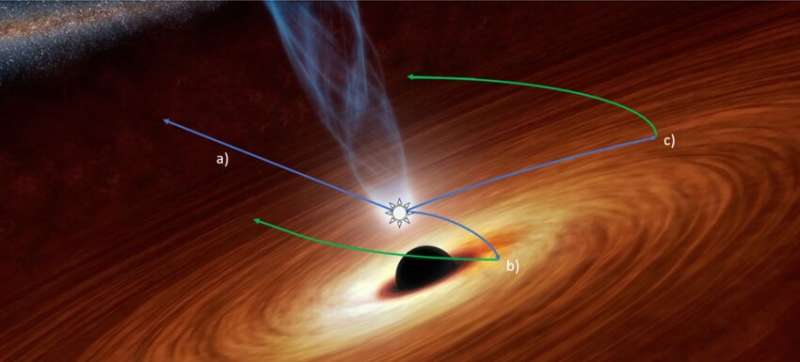This article has been reviewed according to Science X's editorial process and policies. Editors have highlighted the following attributes while ensuring the content's credibility:
fact-checked
trusted source
proofread
Black hole ripples could help pin down expansion of universe

The echoes of light from jets launched from black holes offers a new way to pin down the distance to these exotic objects and to study a largely unobserved population in the center of the Galaxy. It could also even help determine the rate of expansion of the universe. The technique, developed by a team at the University of Newcastle and tested on the archetype black hole Cygnus X-1, was presented by postgraduate researcher and team member Patrick O'Neill at the National Astronomy Meeting in Cardiff.
Most black holes are the compact remnants of stars that ended their lives in supernova explosions. They have such a strong gravitational field that not even light can escape their grasp, hence the description of them as black. Despite that, the influence on their surroundings can be very obvious, as material orbiting a black hole is concentrated into a disk, and can become very hot. This means they are strong sources of X-rays, and many also have associated jets spewing gas and dust out over huge distances.
The calculated distance to most black holes is based on their X-ray brightness and associated measurements of their mass, which can be deduced by how fast material swirls around them. O'Neill and the other team members take a different approach.
Light from the black hole jet is emitted in all directions, so this reaches the disk. Just like a mirror, the disk then reflects some part of the incoming light. Starting from the innermost part of the disk, the reflected light will ripple outwards as the light emitted in the jet takes longer to reach the outer parts of the disk. This "reverberation" of light is akin to a sound echo.
This effectively means we see the light originating from the jet in two ways: the light that travels directly to us, and the light that is reflected by the disk. By simultaneously monitoring the brightness of the light that travels directly to us and the light that is reflected, it becomes possible to deduce how far the jet is above the disk. It also tells astronomers how close the inner boundary of the disk is to the black hole itself. Closer in the gravitational field of the black hole disrupts the shape of the disk.
Monitoring the light emitted from the black hole jet and its surrounding disk together enables the team to calculate the size of the disk, and the fraction of the light it reflects. That gives an absolute measurement of the brightness of the disk, and hence the distance to the black hole-disk system.
Dense clouds of gas and dust typically block infrared, visible and ultraviolet light emitted from the centers of galaxies (including our own), restricting our view. In contrast, X-rays can cross these regions unimpeded, so it should be possible to measure the distance to supermassive black holes. If that can be done, it will be a new way of determining how fast the universe is expanding, something still not settled 94 years after the discovery of the expansion itself.
It is also a powerful tool for probing the population of black holes in the center of the galaxy. Up to now astronomers tended to observe black holes that were relatively light, and away from the plane of the galaxy where most stars are found (our galaxy has spiral arms in a flat disk winding out from a central bar).
Sometimes a black hole and a massive star orbit each other in a binary system. If the massive star explodes as a supernova, the black hole can be thrown out of the plane of the galaxy. The heavier the black hole, the smaller the acceleration, so heavier mass black holes will be found closer to the galactic plane and in the galactic center.
O'Neill says, "Often we are limited to observations of distant galaxies to make inferences about the Milky Way. This cutting-edge technique offers a method of probing the previously concealed galactic center, offering a new insights into the evolution of our own galaxy and how black holes accrete material [MOU1] . It's also exciting to think that we could help to establish the rate at which the universe is expanding—and get a better understanding of its future."
The team now want to build up a picture of the population of black holes in the center of the galaxy. This could help find objects like intermediate mass black holes, objects thought to result from the mergers of black holes from single stars, and a step on the way to forming the monster-sized supermassive black holes found in the center of most galaxies.
Provided by Royal Astronomical Society





















